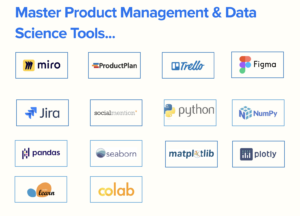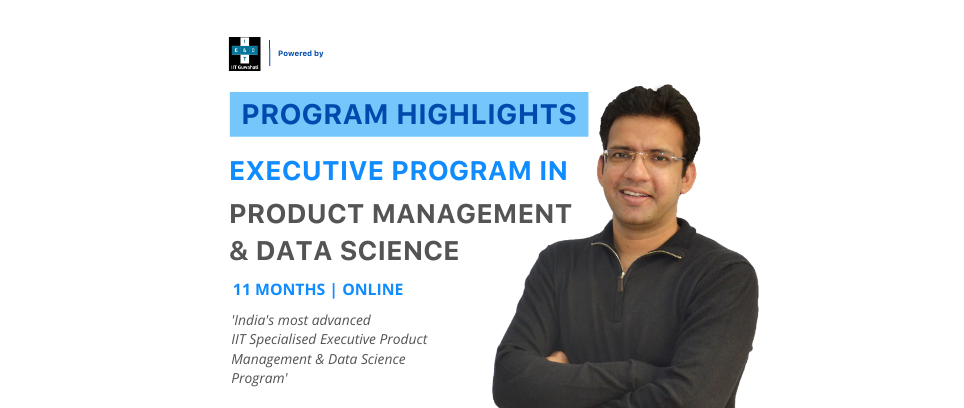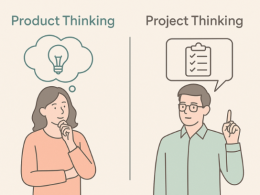Are you familiar with the legendary “IIT” tag? Does it ignite a spark of excitement, knowing that it can catapult your status and career trajectory to new heights?
Picture a life without it – it just wouldn’t be the same! In India, the “IIT” tag holds unparalleled prestige, reserved for a select group of tech enthusiasts.
The moment people discover you’re an IITian, they’re immediately drawn in, eager to uncover the secrets of your prestigious journey or how they too can prepare for this coveted path. And when those moments arrive, one can’t help but feel invincible, on top of the world!
We bring forth a phenomenal opportunity to enrich your career with the esteemed IIT credentials, irrespective of your educational background. Behold the Executive Program in Product Management & Data Science, offered in collaboration with the illustrious E&ICT Academy at the prestigious Indian Institute of Technology, Guwahati.
Embrace this unique chance to elevate your management skills and expertise under the guidance of top industry experts as faculty and cutting-edge resources. The program promises to be a game-changer, propelling your product management career to unimaginable heights.
Ranked 7th in Engineering and 8th in the Overall category in the NIRF India Rankings 2021, IIT Guwahati stands tall as a public technical university established by the Government of India, nestled in the serene Amingaon, North Guwahati, Assam.
Stay tuned for our blog, where we’ll delve into the captivating course details. Don’t forget to save it for future reference and share the excitement with your fellow data enthusiasts!
So, let’s embark on this exhilarating journey together! 🚀
Program Highlights:
This program is designed for a diverse range of professionals, including software developers, consultants, tech leads, product managers, marketing and sales professionals, project managers, business analysts, engineers, and mid-career professionals.
- Certification: Give your resume the IIT edge
- 11 Months: Online Instructor-led Classes
- Top Faculty: Learn from top PMs from Google, Amazon etc.
- 120+ Hours: Intensive training
- 100% Live: Instructor-Led Training
- Placements: 100% Career Assistance

Key Takeaways:
1. Learn Product Strategy
Developing a strategic vision for a product, defining product goals, and aligning them with business objectives.
2. Become a World-Class PM
Understanding the end-to-end product development process, from ideation to launch and post-launch activities.
3. Master Product Roadmaps
Create product roadmaps that outline the product’s future direction, milestones, and feature prioritization.
4. Make Data-Driven Decisions
Utilize data analysis and metrics to inform product decisions, track product performance, and iterate on product features
5. Build a User-Centric Mindset
Learn how to put the user at the center of product development. This involves empathy and understanding of user needs.
6. Unlock Product Roles
Get ready for roles like Associate Product Manager, Product Manager, Senior Product Manager or Product Owner
Program Syllabus:
The Executive Program in Product Management includes the following modules:
Term 1: Introduction to Product Management
Module 1 – Roles & Responsibilities of a PM
- Mindset of PM
- Skills required to be a PM
- Key Responsibilities of a PM
- Influence without authority as PM
Module 2 – User Research for PMs
- Identifying Target User groups
- Quantitative Research Techniques
- Qualitative Research Techniques
- How to Conduct Customer Research
Module 3 – Market Research for PMs
- Defining the Target Market
- Identifying & Analyzing Market Trends
- Market Segmentation and Targeting
- Emerging Trends in Market Research
Module 4 – Competitive Analysis for PMs
- Techniques to identify competitors
- Competitive Intelligence for PMs
- Analyzing Competitive Products
- Competitive SWOT Analysis
Term 2: Product Strategy & Roadmap
Module 5 – What is Product Planning Cycle?
- Understanding the Product planning cycle
- Brief introduction of PPC elements
- Importance of elemets of PPC
- Flow of PPC
Module 6 – Establishing Product Vision & Mission
- What is Product Vision?
- Setting Product Vision
- What is Product Mission?
- Setting Product Mission
Module 7 – Formulating Product Strategy & Product Goals
- What is Product Strategy?
- Setting Product Strategy
- Understanding and setting product goals
- Activity: Strategy Teardown
Module 8 – What is Product Backlog & Roadmap
- What is Product Roadmap?
- Creating Roadmap
- Understanding product backlogs
- How to create efficient product backlogs?
Term 3: Design Thinking & UI/UX
Module 9 – Design Thinking for PMs
- Design Thinking in PM
- Implementing Design Thinking
- How does Design Thinking benefit PM?
- Activity: Design Teardown (Airbnb)
Module 10 – Building MVP – Artefacts, Persona Mapping & PRDs
- How to build an MVP?
- Persona Mapping, User Journey, & User Stories
- Product Artefacts
- What are PRDs?
Module 11 – UI/UX for PMs
- What is UI/UX?
- Building products with good UX
- Tools for UI/UX design
- Case study about product UX
Module 12 – Designing Mockups, Wireframes, & Prototypes
- What are Mockups?
- What are Wireframes?
- What are Prototypes?
- Activity: UI/UX Wizard
Term 4: Agile Product Engineering
Module 13 – Introduction to Engineering for Product Managers
- What is Product Engineering?
- The mindset of a Technical PM
- Should PM learn to code?
- Technical concepts for PM
Module 14 – Understanding Microservices & Cloud Services
- What are Microservices & Cloud Services?
- What is System Design?
- Understanding content delivery network
- Native apps & Hybrid apps
Module 15 – Waterfall & Agile Methodology
- What is Waterfall Methodology?
- What is Agile Methodology?
- Traditional Vs Agile
- Levels of Planning in Agile Methodology
Module 16 – Understanding Scrum & Kanban
- Agile Frameworks
- What are Scrum and Kanban?
- Tools for Scrum & Kanban
- Activity: Futurist
Term 5: Product Marketing & Launch
Module 17 – Product Development & Planning User Tests
- Creating story & planning sprint
- Task breakdown & preparing documentation
- Planning, Recruiting, & Preparing for test
- Conducting Tests & Analyzing Data
Module 18 – Product Launch & A/B Testing
- Risk Analysis
- A/B Testing
- Customer Feedback Mechanism
- Case Study
Module 19 – Data-Driven Product Marketing & Consumer Behaviour
- What is Product Marketing?
- Go-to-Market
- Growth Hacking & Sales strategies
- Understanding Consumer behavior
Module 20 – Measuring Brand & Impact of Product Marketing
- Importance of a Brand
- Building Brand
- Understanding Brand Management
- Measuring the Impact of Product Marketing Activities
Project: Design Discovery
Design Discovery requires one to apply design thinking concepts to create
human-centered and action-oriented solutions. As a PM practitioner, you will
be competing with the best to solve a complex challenge.
Term 6: Data Analysis with Python
Module 21 – Data Science Fundamentals
- Thought Experiment: Data Science from a layman’s perspective
- Brief Intro to Data Science
- How do companies use Data Science?
- Overview of Data Science Project Lifecycle
- Walkthrough of data types and data challenges
Module 22 – Recap: Python for Data Science
- In-class quiz for Python Basics
- Common Python concepts and sample questions
- Variable, Inbuilt datatypes, functions, modules, and Packages
- File Operations and Error Handling
Module 23 – Recap: Statistics for Data Science
- In-class quiz for Descriptive Statistics
- Common charts used
- In-class quiz for Inferential Statistics
- Probability, Central Limit Theorem, Normal Distribution & Hypothesis testing
Module 24 – Data Operations with NumPy
- Introduction to Numpy Arrays
- How to apply mathematical operations in Numpy
- Array manipulation using Numpy
- Broadcast values across Arrays using Numpy
Module 25 – Data Manipulation with Pandas
- Types of Data Structures in Pandas
- Clean data using Pandas
- Manipulating data in Pandas
- How to deal with missing values?
- Hands-on: Implement Numpy arrays and Pandas Dataframes
Term 7: Data Visualization Techniques
Module 26 – Introduction to Data Visualization
- Brief Introduction to Data Visualization
- Advantages and Applications of Data Visualization.
- Univariate Statistical charts
- Bivariate Statistical charts
- Multivariate Statistical charts
Module 27 – Data Visualization using Matplotlib
- Introduction to Python’s Data Visualization library – Matplotlib
- Basic usage of Matplotlib
- Using Matplotlib to plot statistical charts
- Labeling the plots using Matplotlib
Module 28 – Hands-on Pandas for Rapid Visualization
- Understanding the Role of Product Management
- Defining Product Vision & Strategy
- Identifying key Stakeholders & Managing expectations
Module 29 – Seaborn for Data Visualization
- Seaborn Data Visualization Library Introduction
- Importing and setting up seaborn
- Using Seaborn to plot different statistical charts
- Adding details to seaborn charts using matplotlib
Term 8: EDA & Data Storytelling
Module 30 – Introduction to Exploratory Data Analysis
- Introduction to Exploratory Data Analysis (EDA) steps
- Purpose of EDA
- Advantages of EDA
- Applications of EDA
Module 31 – EDA Framework Deep Dive
- Framework for Scientific Exploration
- Case study: Perform EDA to explore survival using the Titanic dataset
- Apply the EDA framework to a real-world Dataset.
- Generate insights and create a story around them.
Module 32 -Scientific Exploration of Industry Data – I & II
- Case study: Perform EDA to explore the Online Retail dataset
- Implement the EDA steps and framework in the retail domain.
- Case study: Analyze the mental health of IT professionals
- Implement the EDA steps and framework on healthcare in industries.
Module 33 – Student Presentations & Insight Delivery
- Student-hosted Project Delivery Sessions.
- Sessions are coordinated by the instructor.
- Storytelling using generated insights.
- Best practices for Data Visualization and Insight Delivery.
Term 9: Machine Learning Foundation
Module 34 -Introduction to Machine Learning (ML)
- What does Machine Learning mean?
- Popular applications of Machine Learning
- Types of Machine Learning – Supervised to Unsupervised methods
- Machine Learning Workflow
Module 35 – Linear Regression
- Supervised Learning: Introduction to Linear Regression
- Use cases of Linear Regression
- How to fit a Linear Regression model?
- Evaluating and interpreting results from Linear Regression models
- Case study: How linear regression helps determine demand?
Module 36 – Logistic Regression
- Supervised Learning: Introduction to Logistic Regression
- Logistic Regression use cases
- Understand the use of Odds Ratio & Logit Function to perform Logistic Regression
- Case study: Predicting default cases in the Banking Industry
Module 37 – Model Evaluation Techniques
- Introduction to evaluation metrics and model selection in Machine Learning
- Importance of Confusion Matrix for Predictions
- Measures of model evaluation – Sensitivity, Specificity, Precision, Recall & F1 Score, AUC-ROC Curve
- Case study: Applying model evaluation techniques to prior case study
Term 10: Machine Learning Intermediate
Module 38 – Decision Trees
- Supervised Learning: Introduction to Decision Trees
- Understanding criterion (Entropy & Information Gain) used in Decision Trees
- Case study: Predict passengers’ survival in a Ship mishap
Module 39 – Random Forests
- Supervised Learning: Introduction to Random Forest
- Using Ensemble Methods in Decision Trees
- Applications of Random Forest
- Case study: Predict passengers’ survival in a Ship mishap
Module 40 – Dimensionality Reduction using PCA
- Unsupervised Learning: Introduction to the Curse of Dimensionality
- What is dimensionality reduction?
- The techniques used in PCA to reduce dimensions
- Applications of Principle Component Analysis (PCA)
- Case study: Optimize model performance using PCA on high dimension dataset
Module 41 – Naïve Bayes Classifier
- Introduction to Naïve Bayes classification
- Refresher on Probability theory
- Applications of Naive Bayes Algorithm in Machine Learning
- Case study: Classify Junk emails based on probability call & F1 Score
Term 11: Machine Learning Advanced
Module 42 – KNN (K- Nearest neighbors)
- Introduction to KNN
- Calculate neighbors using distance measures
- Find the optimal value of K in the KNN method
- Advantages & Disadvantages of KNN
- Case Study: Classify malicious websites using the close neighbor technique
Module 43 – K-means Clustering
- Introduction to K-means clustering
- Decide clusters by adjusting centroids
- Find optimal ‘k value’ in K-means
- Understand applications of clustering in Machine Learning
- Case study: Segment flower species in Iris flower data
Module 44 – Ensemble Learning
- Introduction to Ensemble Learning
- What are Bagging and Boosting Techniques?
- What is the Bias variance trade-off?
- Case study: Predict wage classes across adults
Module 45 – Optimization
- Introduction to Optimization in ML
- Applications of optimization methods
- Optimization techniques: Linear Programming using Excel solver
- How does Stochastic Gradient Descent (SGD) Work?
- Case study: Applying SGD to data
Admission Process:
- Apply at iitg.accredian.com
- Pay the Application Fee
- Selected Candidates will receive Admission Confirmation Letter.
Start Your Journey Today at E&ICT IIT Guwahati without quitting your job!
ACCREDIAN‘s primary focus revolves around the instruction and exploration of cutting-edge technologies, including AI, ML, Data Science, and Product Management.
Our dedication lies in providing specialized programs that cater to industry demands, aiming to empower working professionals with essential skill sets and life-changing learning opportunities, propelling their careers forward.
Our ultimate mission centers on ensuring that world-class education becomes accessible to all, enabling individuals to pursue impactful careers and achieve their highest potential.
Do you have any queries?
Reach out to us at [email protected]
Talk to our Program Mentor at +91 96258 11095






